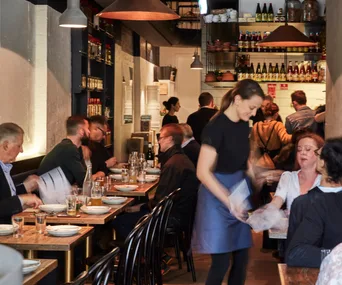My cooking career has been, in a word, eclectic. I started kitchen life in a modern British restaurant in London before globe-hopping back home to Sydney only to land in a French bistro. From there I had a brief moment in a less-than-traditional Japanese joint, after which I moved to China (or at least an outpost of China on Crown Street in Surry Hills).
There I stayed, gaining an appreciation of produce, provenance and the delights of cooking in a wok. From there I went one suburb over to a shiny new spot where I was given free rein. The only caveat: it had to be Italian. Happily, I complied, curing meats, making pasta and focusing on the seasons. Slowly, though, curry leaves crept in.
All this country criss-crossing has had an effect. I look at the similar threads in these cuisines and let that inform and inspire my cooking. When I begin building a dish or a menu, I start with a particular country’s cuisine in mind. This, coupled with a particular ingredient or season, becomes the base to which I add other flavours.
The food of my Sri Lankan heritage is the anchor to the recipes here. The pipi dish, for instance, had its inspiration in a curry cooked for me on a coconut plantation. I added anchovies for sea-richness and speck for its hint of smoke and unexpected appeal with the creamy coconut milk. From here the ideas grew and suddenly we have a collection that brings to mind a Sri Lankan cooking in northern Italy in the autumn. Serve any of these dishes alone and you’ll find flavour aplenty; together they’re a banquet of complementary delights.
The seeni sambol on the eggs is a traditional Sri Lankan condiment yet also echoes the flavour of an Italian agrodolce. The clams are sauced with bay and curry leaves that work like a perfect marriage of two different cultures. The beef dish has a stronger, darker flavour, tangy with tamarind that, along with the spicy, sharp rhubarb pickle, cuts through the fattiness of brisket. The cabbage dish, flavourful yet understated, adds crunch. Then there’s curd and kithul, for dessert – again, simple ingredients that come to a refreshing end.
Lankan Filling Station, Ground Floor, 58 Riley St, East Sydney, NSW, lankanfillingstation.com.au

Fried eggs with seeni sambol, coconut and turmeric
“I first cooked a version of this dish – inspired by the excellent deep-fried egg dish at Billy Kwong – while working at a restaurant in Sri Lanka,” says Carey. “The lattice-like eggs are doused in a creamy turmeric curry sauce and topped with seeni sambol, a sweet-spiced caramelised onion relish. This dish is equally perfect for an indulgent breakfast as it is served as part of a larger meal.”

Pipis with bay leaves and gentle curry sauce
“This is a delicately spiced curry dish with lots of green flavours – bay leaves, green chilli – and a light curry powder,” says Carey. “The base has speck in it, which gives a lovely smoky note, as well as adding richness. This dish uses some of my favourite flavours from both Italy and Sri Lanka.”

“The flavours of this dish are based on a dry black curry traditionally made with wild boar,” says Carey. “The secret is in toasting the spices until they’re almost but not quite burnt. Rich with sweet spices and soured with tamarind, this is a robust, spicy and hot dish.”

Cabbage mallung and rhubarb achcharu
“Most meals in Sri Lanka are made up of an array of dishes and more often than not feature a mallung,” says Carey. “Mallung is a shredded vegetable dish that’s lightly cooked, generally without fat of any kind, with fresh coconut and any array of spices and chilli, almost like a warm salad. There is a huge range of bitter, medicinal and wild greens that you can use. This recipe is a very simple cabbage version with butter and only very gently spiced.”
“Achcharu is a Sri Lankan pickled vegetable mix usually made with mustard seeds, ginger and an array of vegetables,” says Carey. “This is a sweet and hot version, perfect with the brisket or any other rich meat dishes.”

“Love cake is a truly delicious, rich cake with an almost fudge-like centre,” says Carey. “Fragrant with spices, it’s made with semolina and cashew nuts and undoubtedly evolved from the Portuguese influence on the island. Growing up, my nan would occasionally send us a slab, a cause for much rejoicing – hers was, obviously, the best. Nan’s recipe is a closely guarded secret that I can’t give away, but here is my version, which is nearly as good.”

Fresh kefir curd with kithul, roasted coconut and apple
“The flavours in this cleansing dessert combine to give a taste that’s greater than its simple parts would have you imagine,” says Carey. “Buffalo curd is everywhere in Sri Lanka and is often served as a dessert with kithul, a palm-sugar treacle. I make a yoghurt, using kefir and unhomogenised cow’s milk, that I find has a texture similar to buffalo curd. Making your own yoghurt using kefir is a process of trial and error – though relatively easy, the organic quality of the kefir grain can cause things to happen in unexpected ways. This recipe makes more than you’ll need, but the curd will keep for a good few weeks in the fridge. Feel free to substitute your favourite yoghurt instead.”


